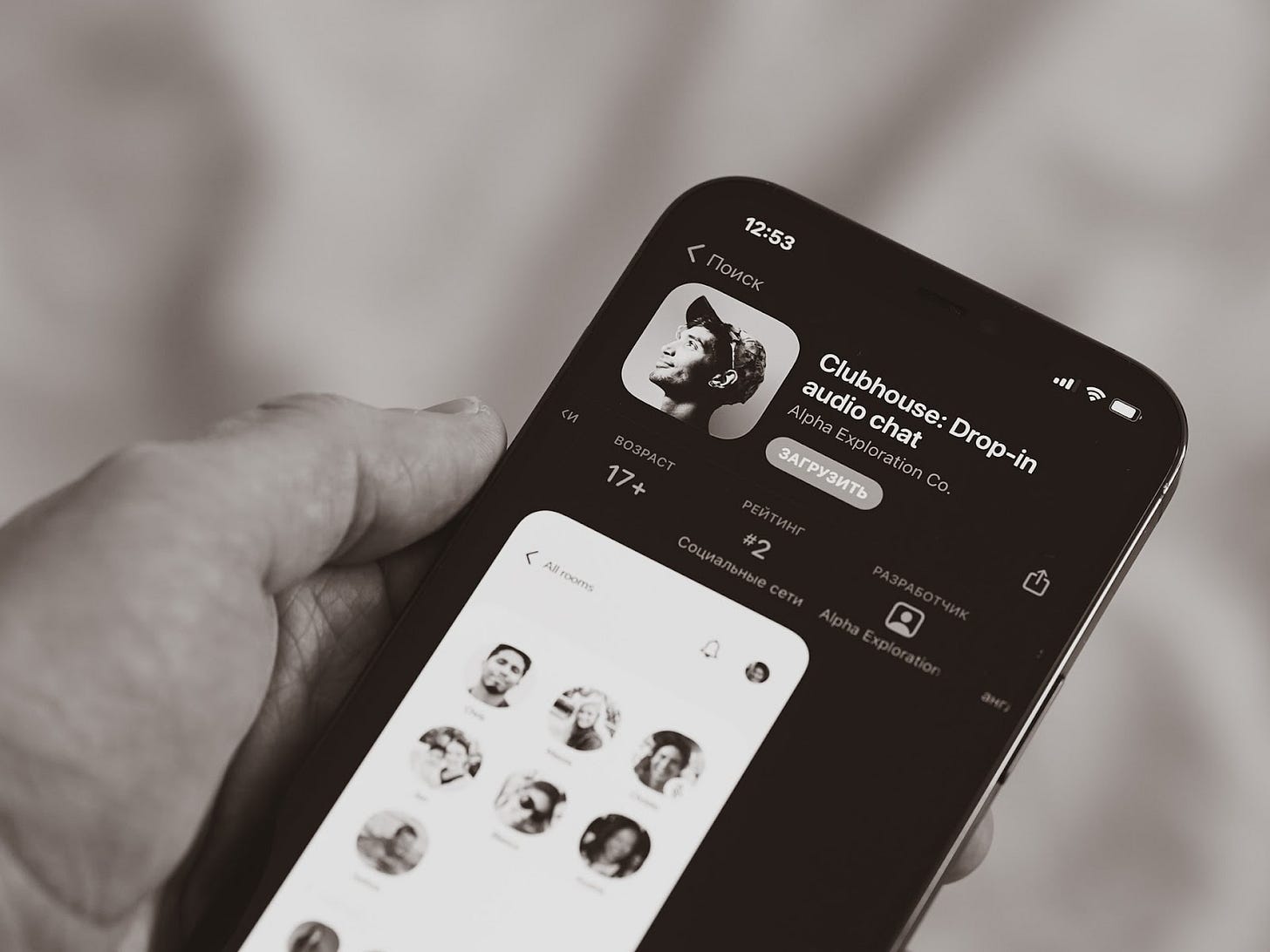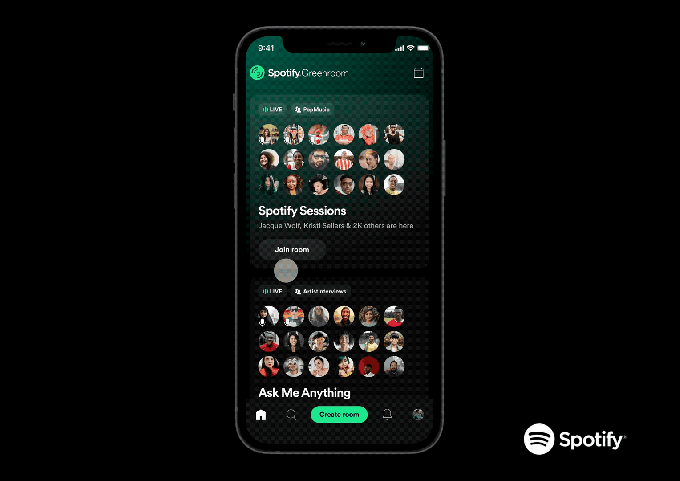#114 - Dropbox 2.0 (From the Archives)
Clubhouse, The Rise of Live Audio, and The Dangers of Early Hype
Hi 👋 - Dipping into the archives this week with a look at how the early hype surrounding Clubhouse, a live audio app, might cause its downfall. Thanks for reading.
🎤 If you’re finding this content valuable, consider sharing it with friends or coworkers.
🎤 For more like this once a week, consider subscribing.
Empty Subway Cars
There’s always a reason why a subway car is empty during rush hour. Always.
New York City has many rites of passage, like finding out the hard way the difference between an express and local train or falling asleep on the F and waking up in Coney Island. For the nocturnal set, another is waiting in line outside a club, only to find out that it’s empty when you finally get in. Which brings us to Clubhouse.
Clubhouse is a live audio app that launched on iOS in March 2020. It generated a lot of buzz during Covid-19 lockdowns, particularly with the Allbirds crowd. By May 2020, Clubhouse was valued at $100 million. Less than a year later, its valuation skyrocketed to $4 billion. High profile talks like an interview with Elon Musk, complete with a cameo from Robinhood CEO Vlad Tenev, drew a large audiences and generated headlines. The product was initially invite-only and demand for invites was so hot that they began selling on eBay1.
Things have since cooled off. According to Sensor Tower, Clubhouse monthly app downloads peaked at 9.6 million in February 2021 before plummeting to 922,000 in April 2021, a 90% drop:

The launch of an Android app resuscitated Clubhouse in May and June 2021, driven by downloads in India:
Both spikes in downloads were short-lived. In July of 2021, Clubhouse ended the waitlist and invite system and opened the app up to everyone. It’s unclear if the company will fare better than an empty club with a line outside. As of Saturday, August 14, Clubhouse was the 35th most popular social networking app in the App Store. It’s slightly more popular than dating apps Grindr and OkCupid, and slightly less popular than Wink and Tagged, two apps I’ve never heard of:
Hype Subsidies & Hype Taxes
Hype can make or break a consumer social start-up. The more users a social app has, the more valuable it becomes. People what to be where other people are, which explains the allure of lines and the repulsion of an empty club. The upside of hype is that it attracts new users, making a network more valuable, attracting more users.
Sarah Tavel, a general partner at Benchmark, views hype as a subsidy or a tax. With subsidies, a startup (or their VC) covers part of a transaction's cost to jumpstart marketplace liquidity, allowing a sub-scale marketplace to act as if it’s at critical mass2. This was a popular tactic with on-demand marketplaces like DoorDash, Lyft, and Uber. Pre-pandemic, it was possible to get a $12 Uber ride from Prospect Heights to Williamsburg that would cost $20 or more in a yellow cab (if you could find one in Brooklyn). By attracting new users, hype is like a subsidy, encouraging behavior that wouldn’t happen organically.
A big difference between a subsidy and hype is control. You can tweak a subsidy up or down (10% off, 15% off…), but not hype. Hype is completely out of a company’s control. One week you’re 20% off, the next week 80% off, the next week 45% off. That’s a challenging way to run a business. Tavel refers to this as the hype-market fit:
In this way, hype applied too early in a network’s evolution can doom it because it makes it extraordinarily difficult in the beginning to know how consumers will engage once the hype subsidy is removed. You risk optimizing for the wrong things.
Another risk, particularly for early stage companies, is that the product cracks under the strain of traffic. While hype attracts new users, a poor product experience can cause them to flee. This is why Tavel encourages her portfolio companies to avoid hype as much as possible until they’ve got the product working well. If your funnel is leaky, you won’t be benefit from a surge of traffic.
The last, and perhaps deadliest, risk of hype is that it attracts competition. If you discover a gold mine, it’s best to dig a moat around it before you tell everyone where it is.
Speed to Copy
Paradoxically, Clubhouse’s early success might doom it to failure. The company is a case study in how hype catalyzes competition. Scaled online platforms like Facebook, Spotify, and Twitter have big checkbooks, large engineering teams, massive user bases, and a deep-seated paranoia about losing users or attention. Their reaction to Clubhouse shows how quickly they can move to neutralize a potential threat.
Snapchat Stories is the canonical example of copying in consumer social. The company launched Stores in October 2013. At the time it had around 60 million app downloads and 30 million monthly active users. Today the Stories format has been copied everywhere from Facebook and Instagram to LinkedIn.
Fortunately, Snapchat was a multi-feature company and it competitors took time to launch their own Stores format. For example, Instagram launched Stories 34 months later in August 2016 and Facebook introduced the feature 41 months later in March 2017. Twitter and LinkedIn both launched Stories in 2020. While these companies knocked-off Snapchat, they did it on a time scale that gave the company an opportunity to grow its network and innovate on its product.

Clubhouse isn’t so lucky. Since 2013, consumer social has become more competitive and time to copy has sped up. While Snapchat had years before competitors cloned Stories, Clubhouse only had months before live audio started popping up in other apps.

Discord launched Stage Channels in March 2021, a year after Clubhouse. This was followed by a salvo when Facebook, Slack, Spotify, and Twitter launched their respective live audio products between May and June. Fifteen months after launch, Clubhouse was competing with over $1.2 trillion of market cap. That’s the downside of hype.
Network effects cut both ways. According to Metcalfe’s Law3, the value of a network is proportional to the square of the number of users connected to the system. Networks become more valuable as more users join and less valuable as users leave. Consumer social companies like Facebook and Twitter are hyper-aware of this math and always on the defensive for anything that could pull users away or compete for their attention. Like Snapchat Stories, Clubhouse’s early hype was a signal to the product teams to incorporate a hot feature or risk losing users or their attention.
A Feature, Not a Product
Steve Jobs famously called Dropbox a feature, not a product. Consumer social companies are determined to turn Clubhouse into Dropbox 2.0 by making sure that social audio remains a feature and doesn’t become a viable standalone business.
Between March and June of 2021, a slew of Clubhouse competitors have been introduced:
Discord Stage Channels: Launched in March 2021, Stage Channels allows people to broadcast live audio to a group of listeners. Like Discord, Stage Channels is broadly available across platforms: Android, Linux iOS Windows, Mac, and Windows4.
Facebook Live Audio Rooms: Launched in June 2021 as part of Facebook’s campaign to woo creators, Live Audio Rooms is currently available to verified creators, public figures, and select Facebook Groups in the US. All Facebook users in the US can listen to Live Audio Rooms. Discovery happens through notifications and New Feed prompts. Additionally, users can sign up to be reminded when a room goes live. Facebook is also experimenting with live audio monetization.

Slack Huddles: Slack launched Huddles in June 2021 to try to replicate short, spontaneous conversations. Huddles can be launched directly from a channel or DM and includes a screen-sharing option.
Spotify Greenroom: Born from the sports-focused Locker Room (Betty Labs) acquisition, Spotify Greenroom is a standalone app that lets users join or host live audio rooms. Content is focused on culture, entertainment, music, and sports. Rooms are currently capped at 1,000 attendees, but that will be relaxed over time. The app enhances Spotify’s podcast strategy, by giving hosts the option of turning their room into a podcast, providing a potential source of gross margin enhancing user-generated content. Spotify plans to add personalization from its core app to Greenroom in the future5.
Twitter Spaces: Twitter began testing Spaces in late 2020 with a full launch in May 2021. Accounts with at least 600 followers are able to create a Space. Users can join a Space from a post in their feed. Currently, Twitter is devoting the prime real estate at the top of the feed to spaces, signaling that it's serious about live audio. Twitter plans to add monetization features like Ticketed Spaces in the future.
Stuck Between a Rock and a Dropbox
Synchronous content like Clubhouse needs to overcome the critical mass problem. To succeed, the company not only needs to drive traffic, but needs to drive it at specific times. Initially, this was its draw. If you’re not there, you miss out. FOMO can be a good customer acquisition strategy. However, as competition increases, it increasingly looks like a vulnerability.
Clubhouse only has one way to win: live audio. In contrast, scaled platforms like Spotify have multiple ways to win: live, music, and podcasts. Adding the option for a creator to record their live room and turn it into a podcast was a strategic masterstroke for Spotify. Recording reduces the need for people to come live. Spotify is simultaneously advancing its audio strategy while hamstringing Clubhouse. Similarly, Facebook and Twitter have other avenues to engage and monetize users. They don’t need to win with live audio, they just need not to lose their existing audiences.
Recently, Clubhouse has signed a deal with TED Talks for exclusive content. It has also expanded beyond live audio by adding a text-based chat feature called Back Channel. Giving users more reasons to visit and spend time in the app is a good idea, but Clubhouse is severely outgunned. For example, over the past two years, Spotify has spent hundreds of millions of dollars on exclusive podcast deals and Facebook is devoting more resources to creators, one of its four strategic priorities.
Building a network from scratch is difficult under the best of circumstances. The boom of competition makes Clubhouse’s path forward much harder. Today, Clubhouse is an empty club with no line outside. It’s competing against Facebook, Spotify, and Twitter who are already packed and have plenty of resources to keep the party going.
🎤 If you’re finding this content valuable, consider sharing it with friends or coworkers.
🎤 For more like this once a week, consider subscribing.
More Good Reads
Benchmark general partner Sarah Tavel on why early hype is dangerous in consumer social. Building a network from scratch is hard. TikTok managed to do it algorithmically, without a social graph. Eugene Wei on TikTok’s algorithm. Below the Line on the battle for your ears.
Disclosure: The author owns shares in Facebook.

The New Yorker, Clubhouse Feels Like a Party, March 31, 2021.
Sarah Tavel, The Hype Subsidy – Why Early Hype is Dangerous in Consumer Social, July 27, 2021.
Wikipedia contributors, "Metcalfe's law," Wikipedia, The Free Encyclopedia,https://en.wikipedia.org/w/index.php?title=Metcalfe%27s_law&oldid=1017563847 (accessed August 14, 2021).
The Verge, Discord’s new Clubhouse-like feature, Stage Channels, is available now, March 31, 2021.
TechCrunch, Spotify launches its live audio app and Clubhouse rival, Spotify Greenroom, June 16, 2021.






